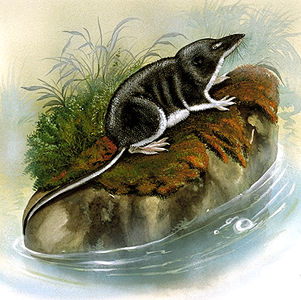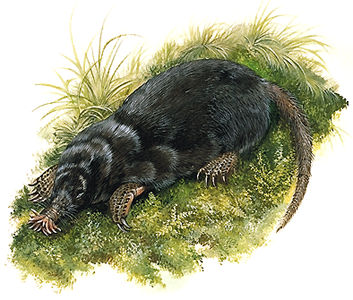Insectivora, order of mammals containing 7 living families: shrews (Soricidae), moles (Talpidae), hedgehogs (Erinaceidae), tenrecs (Tenrecidae), otter shrews (Potamogalidae), golden moles (Chrysochloridae) and solenodons (Solenodontidae). There are approximately 350 living species, widely distributed in Africa, Eurasia, N America and northern S America. The 22 species found in Canada belong to the Talpidae and Soricidae.
Description
Generally, insectivores are small, ranging in size from 2 g (Etruscan shrew, Suncus etruscus, the world's smallest mammal) to about 1.5 kg (moon rat, Echinosorex gymnurus). Insectivores demonstrate primitive characteristics, although some (eg, moles) show adaptations to highly specialized ways of life. They are plantigrade (eg, walk on sole and heel) and have 5 clawed toes on each foot.
The nose tends to be pointed and tubular; eyes and ears are generally small. The tail may be long or greatly reduced. The skull is primitive in form, with a low brain case and a small cranial cavity containing a brain with smooth cerebral hemispheres. The teeth are adapted for crushing or cutting. Although insectivores primarily eat insects, some species are omnivorous.
Evolution
Many, perhaps all, other orders of placental mammals evolved from the early insectivores. The order has been traced back to the Cretaceous (144.2-65 million years ago) in Asia and N America. Ancestors of shrews can be traced back to the Oligocene (34-23.7 million years ago) in Europe and N America; those of the males to the late Eocene (about 40 million years ago) in Europe.

 Share on Facebook
Share on Facebook Share on X
Share on X Share by Email
Share by Email Share on Google Classroom
Share on Google Classroom






